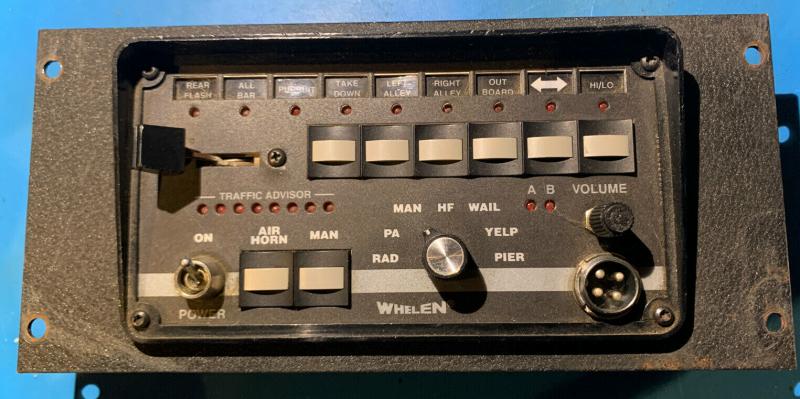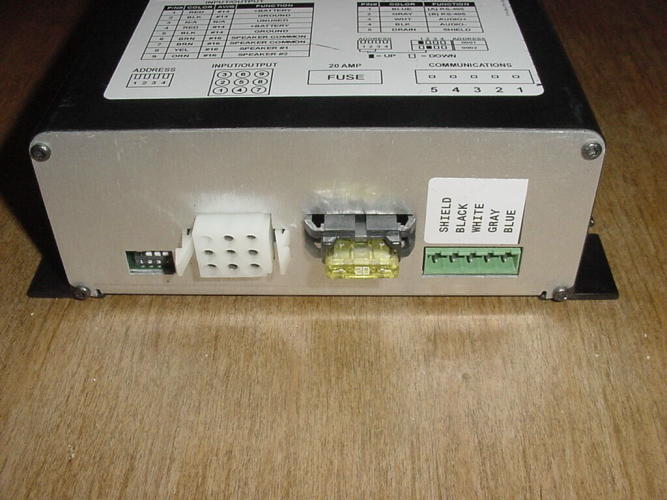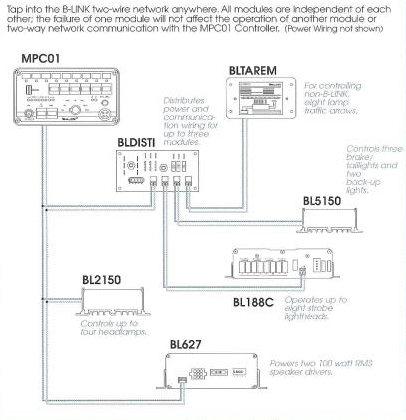B-LINK™
Drive into the next century with B-LINK, the leading field proven technology in automotive emergency warning. B-LINK is a Networked Vehicle Warning System (NVWS) that integrates all light and siren equipment on a vehicle so it works as a total warning system and provides increased safety for all.

- Directs all warning operations with one controller.
- “HANDS-FREE” Light and Siren operation.
- Performs pre-programmed sequence of operations from single switch.
- Enhances use of multilevel lighting and siren warning.
- Eliminates bulky control wiring and reduces cockpit clutter.
- Permits equipment additions and reconfigurations without revising control wiring.
- Provides instant operating status of all warning equipment within system.
Models:
102000 – 4 front, 4 rear strobes
102H0 – 4 front, 4 rear strobes, two front, two side halogens
1020H – 4 front, 4 rear strobes, 1 front center, 3 rear halogens
102HH – 4 front, 4 rear strobes, 3 front, 3 rear and 2 side halogens
102I0 – 4 front, 4 rear strobes, 2 front, 2 side immobilizers
102IH – 4 front, 4 rear strobes, 1 front, 3 rear halogens, 2 front, 2 side immobilizers
102HI – 4 front, 4 rear strobes, 1 front, 4 rear immobilizers, 2 front, 2 side halogens
1020I – 4 front, 4 rear strobes, 1 front, 3 rear immobilizers
102II – 4 front, 4 rear strobes, 3 front, 3 rear, 2 side immobilizers
10300 – 5 front, 7 rear strobes
103H0 – 5 front, 7 rear strobes, 2 front, 2 side halogens (popular model)
103I0 – 5 front, 7 rear strobes, 2 front, 2 side immobilizers
1030H – 6 front, 4 rear, 2 side strobes, 1 front, 3 rear halogens
1030I – 6 front, 4 rear, 2 side strobes, 1 front, 3 rear immobilizers
10400 – 7 front, 7 rear and 2 side strobes
Whelen Serial Communications Primer
Here and there, the topic of the Whelen serial controlled products comes up. I am writing this to provide as much information here as possible to make it a little easier to understand what it can do and its limitations.
Introduced in the 1990’s was the Whelen “BLINK” product. It is now known as part of the “SC” line, which fits in with Whelens two letter designators (HC, LC, SC, ST, etc). Serial components have model numbers starting with “BL”.
Its core market were for large fleet vehicle operations and easy of maintenance of the modules. If a component such as the siren amp failed, all you had to do it disconnect the harness, swap them out and your good go to. Only component that would need to be reprogrammed, if necessary, would be the Multi Purpose Controller (MPC).
(Whelen MPC01 Multi Purpose Controller)
This system consisted of a MPC01 (Multi Purpose Controller), the BL10000 lightbar and the BL627 siren amplifier. This was the core system. What was unique about these products from the standard Whelen offerings is that each operated off of RS485 data stream at 9600bps sent from the MPC01 controller. This controller was programmed from a computer running DOS software and was interfaced thru a special box known as the “Transporter”.
One of the advantages to this RS485 data system is that it only requires one data cable (two wires, plus a drain wire) to each component. This eliminates running multiple 12vDC control wires throughout the vehicle. Due to the data nature of the system, you can daisy chain from one unit to another eliminating multiple runs of data cable from the MPC01. Depending on the component, you can have more than one of the same items in the system (two amps, four flashers, etc).
(Whelen BL627)
In the typical setup, the wires from the MPC01 will run directly to a BL627 siren amp. This is done as audio from the PA mic is routed to the amp via a 5 wire cable. After that, 2 wires are only needed.
What is nice about computer programming a control box, the MPC01 is able to have specific modes of operations for each component in the system on a per switch basis. For instances, you can program slide switch one to operate the front strobes of the BL10000 in a random pattern and the siren to automatically come on. You then could program slide switch 2 to operate just the front corner strobes, and the rear center strobe only. Many different combinations are possible. Each button can have specific programming that is unique to each other buttons. There is a higherachy to the programming in case you have multiple modules operating with different buttons. Slide switch has the highest priority, followed by the push buttons, with the auxiliary inputs as the 3rd. What this means, if you have push button 1 for front strobes, and slide switch 1 as all bar with strobes on a different pattern, the programming for SS1 will override whatever you have button one programmed for, in terms of the strobe operation. If push button 1 just turned on the takedowns and SS1 turned on as above, the TD’s will stay lit. They do not turn off any other function, unless programmed that way.
In addition to custom programming without having to rewire the entire lightbar, each component has built in real time diagnostics. If there is a failure of any component, the MPC will emit a fail tone (if enabled) and flash the LED light on whatever function is running. A manual “all systems: check can also be performed by holding down the last push buttons for 5 seconds. The system will then turn every component on in sequence. SI-Testing of the siren is also available.
Another feature of the MPC01/02/03 is the hands free lightning option. If the unit is in slide switch 3 position, and the siren knob is HF, any press of the MAN button and/or the horn ring will change the siren tone (if setup) and light options (if setup). Commons setups were the first press placed the strobe bars in to single flash mode with the yelp and faster wigwag and taillight flash patterns. To exit out of that mode, all you have to do is move the SS to another position or the siren knob out of HF. So essentially, you can have 4 different modes of operation in the SS3 position and HF mode.
The MPC01 contains the following controls:
- System on/off toggle switch
- Four position slide switch (0,1,2,3)
- Six momentary buttons
- Dedicated air horn button
- Dedicated manual siren button
- 7 position siren knob (Radio repeat, PA, Manual, Handsfree, Wail, Yelp, Pier)
- Microphone input
In addition to the above, the MPC supports two external inputs and two external outputs. All of those four are ground inputs or ground outputs to allow non-BLINK to be controlled, or to be controlled by other products.
Currently, the MPC can be programming with Windows based software called “SC Programmer”.
Whelen Serial Controlled Components
The following are all known model numbers and descriptions of released products
MPC01 – Multipurpose Controller. This is the heart of the system
MPC02 – Same as the MPC01, but omits the siren controls and replaces the airhorn and manual buttons with traffic advisor and low power buttons
MPC03 – This is the “Cencom” style head and newest controller. This head does not require the “Transporter” interface box and can be programmed via a USB cable
MPC-NFPA – This is a modified version of the MPC01 which does not have a slide switch. It allows two inputs for “Calling the Right of Way” and “Blocking the Right of Way”.
BL627 – Siren amplifier. This siren allows for up to two 100 watt speakers, and has the same tone set as the 295 series sirens. In addition to the 295 tones, you can program (via the MPC01/03/NFPA) “composite tones” for wail, yelp, high low and tri-tone. As of 2008, a newer version allows for dip switch control of siren tones such as Power call tones, and the “Q” sound. Up to two siren amps can be installed in a system and allows for in or out of phase tones and multiple tones (one per amp at a time). The pre “new tones” amps can be spotted with it have a 4 position dip switch. The newer model has an 8 position dipswitch.
BL2150 – Standard headlight flasher, first generation. This puts 12vDC + voltage on the headlight wires.
BL2150A – Current headlight flasher. This works the same way as the standard 2150A’s which isolate the lights from the vehicle
*Multiple flash patterns can be used
BL5150 – Standard taillight flasher. This puts 12vDC + voltage on the vehicle wires
BL5150A – Current taillight flasher. This isolates the vehicle and flasher wiring
*Multiple flash patterns can be used
BL74C – 4 outlet, 70 watt comet flash strobe power supply (discontinued in favor of the ISP series)
BL94C – 4 outlet, 90 watt comet flash strobe power supply (discontinued in favor of the ISP series)
BL148C – 8 outlet, 140 watt comet flash strobe power supply (discontinued in favor of the ISP series)
BL188C – 8 outlet, 180 watt comet flash strobe power supply (discontinued in favor of the ISP series)
ISP94 – 4 outlet, 90 watt strobe power supply. Allows BLINK, DOT and conventional operation
ISP188 – 8 outlet, 180 watt strobe power supply. Allows BLINK, DOT and conventional operation
BL405A – Four outlet halogen flasher, supports up to 5 amps per outlet.
BL420A – Four outlet power switch, 20 amps per outlet. Also able to be used as a flasher
*The above can flash at the following rates: 70SF, 140SF, 60DF, steady on
BLTA – This is an 8 lamp traffic advisor. If using a BL10000 lightbar with all rear strobes, you can use the lightbar arrow and this traffic arrow at the same time. This does not work when using an Ultra bar – one or the other in that case.
BLTAREM – This is a traffic advisor controller that you can use any positive switched 8 lamp traffic arrow with
BLTAREM6 – Same as above, but for 6 lights
BLDISTI – Power Distribution Module. If you have a very large installation, you can locate them all in one place, and connect them to one power and data source instead of running multiple power wires to the battery.
BL8140 – This is a high powered relay box. No flashing. This allows control of high (or low) current control of non-serial products. Depending on current needs outputs can range from 40 amps to 10 amps depending on the outlet(s) used.
SMART LINK Series
Whelen offers “prepackaged” systems in six standard configurations.
- SMTLNK1 – MPC01, BL627, BL8140
- SMTLNK2 – MPC01, BL627, BL8140, BLTAREM
- SMTLNK3 – MPC01, BL627, BL8140, BLTAREM6
- SMTLNK4 – MPC01, BL627, BL420A
- SMTLNK5 – MPC01, BL627, BL420A, BLTAREM
- SMTLNK6 – MPC01, BL627, BL420A, BLTAREM6
Whelen Lightbars
There have been several lightbars made available that will work with the serial controllers. Perhaps the best and widely known lightbar is the BL10000 bar with its unique appearance. This bar can be instantly recognizable by its black cover on the top of the bar. It has the same basic form factor as the Edge 9000 series however it’s much wider than the Edge 9000, and slightly wider than the Edge Ultra.
The BL10000 was available in the following configurations:
- 102000 – 4 front, 4 rear strobes
- 102H0 – 4 front, 4 rear strobes, two front, two side halogens
- 1020H – 4 front, 4 rear strobes, 1 front center, 3 rear halogens
- 102HH – 4 front, 4 rear strobes, 3 front, 3 rear and 2 side halogens
- 102I0 – 4 front, 4 rear strobes, 2 front, 2 side immobilizers
- 102IH – 4 front, 4 rear strobes, 1 front, 3 rear halogens, 2 front, 2 side immobilizers
- 102HI – 4 front, 4 rear strobes, 1 front, 4 rear immobilizers, 2 front, 2 side halogens
- 1020I – 4 front, 4 rear strobes, 1 front, 3 rear immobilizers
- 102II – 4 front, 4 rear strobes, 3 front, 3 rear, 2 side immobilizers
- 10300 – 5 front, 7 rear strobes
- 103H0 – 5 front, 7 rear strobes, 2 front, 2 side halogens (popular model)
- 103I0 – 5 front, 7 rear strobes, 2 front, 2 side immobilizers
- 1030H – 6 front, 4 rear, 2 side strobes, 1 front, 3 rear halogens
- 1030I – 6 front, 4 rear, 2 side strobes, 1 front, 3 rear immobilizers
- 10400 – 7 front, 7 rear and 2 side strobes
So now you’re asking, what is the difference between halogens and immobilizers? Simple…no clue! Both are halogen lights to my knowledge, and are capable of steady burn, single or double flash. Other than that, I really don’t know.
The bar is cable of synchronized or “out of phase” strobe patterns and a backlit sign and cruise lights were an option. Integrated into the BL10000 was the ability to do strobe traffic advisor patterns. No matter how many rear strobes you had, it could to left/right/split/in-out. Of course, more strobes you had to the rear the better it looks.
Strobe flash patterns consisted of:
- Simultaneous
- Alternating
- In/Out
- Crossing (strobes left/right)
- Random
Up to three can be selected per mode which it would rotate thru.
Around 1999/2000, when the newer Edge bars were released, the Edge Ultra for serial communications (Edge Ultra SC) replaced the BL10000. This bar could have just about every option that the normal Ultra bar could have. Same goes with the LFL Patriot SC, LFL Liberty SC, LFL Liberty ST (extended corner liberty) and the Freedom Series. As with the BL10000, if you have fully populated rear strobes, the Ultra bar can support a strobe TA. If you desire a split TA or a full halogen TA, an internal T/A controller will have to be bought and installed (unless order from the factory that way).
Serial Communications Off Shoots
A few off shoots of the SC series have been developed that do not require a MPC controller. These would be the Smart Arrow messengers (which can be interfaced into the same data stream, reducing wiring).
For a time, Whelen made a low cost product based on the serial protocol. These were the “Diagnostic” bars and controllers known as the PSDS-9 units. The controllers look just like the PCC-9 series switch boxes but have a red LED light over each push button. If there is a lightbar component failure, the LED will light up to let the user know that something is wrong. To my knowledge these were only factory and not field programmable. Major customers of these were the Connecticut State Police and the Ohio Highway Patrol.
The current byproduct is the WeCan lightbars. They used the same data wire system from the lightbar to a “universal control point”. This control point is programmed via WeCan software, but the bar is then switched using normal means.
Photo Gallery:
Click to enlarge.
Videos:
























